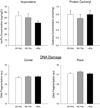Aging, resting metabolic rate, and oxidative damage: results from the Louisiana Healthy Aging Study
- PMID: 17634323
- PMCID: PMC2692620
- DOI: 10.1093/gerona/62.7.752
Aging, resting metabolic rate, and oxidative damage: results from the Louisiana Healthy Aging Study
Abstract
Background: The aging process occurs at variable rates both among and within species and may be related to the variability in oxygen consumption and free radical production impacting oxidative stress. The current study was designed to test whether nonagenarians have a relatively low metabolic rate and whether it is associated with low levels of oxidative stress relative to age.
Methods: Resting metabolic rate (RMR) and markers of oxidative stress to lipids, proteins, and DNA were measured in three groups of individuals aged 20-34 (n=47), 60-74 (n=49), and>or=90 years (n=74).
Results: RMR, adjusted for fat-free mass, fat mass, and sex, was lower in both older groups when compared to the young group (p<or=.0001). There were no significant differences in urinary isoprostanes, serum protein carbonyls, or DNA fragmentation between groups, and RMR was not related to any markers of oxidative stress.
Conclusions: This study confirms an age-related decline in RMR independent of changes in body composition but surprisingly did not show an accumulation of oxidative damage with increasing age. Our data challenge the theory that RMR is a significant determinant of oxidative stress and therefore contributes to the aging process.
Figures


References
-
- Austad SN. Theories of aging: an overview. Aging (Milano) 1998;10:146–147. - PubMed
-
- Greenberg JA. Organ metabolic rates and aging: two hypotheses. Med Hypotheses. 1999;52:15–22. - PubMed
-
- Harman D. Aging: a theory based on free radical and radiation chemistry. J Gerontol. 1956;11:298–300. - PubMed
-
- Ku HH, Brunk UT, Sohal RS. Relationship between mitochondrial superoxide and hydrogen peroxide production and longevity of mammalian species. Free Radic Biol Med. 1993;15:621–627. - PubMed
-
- Sohal RS, Allen RG. Relationship between metabolic rate, free radicals, differentiation and aging: a unified theory. Basic Life Sci. 1985;35:75–104. - PubMed
MeSH terms
Substances
Grants and funding
LinkOut - more resources
Full Text Sources
Medical

